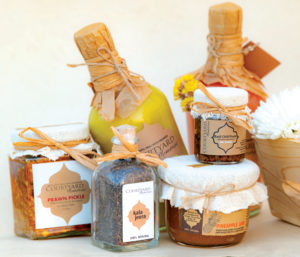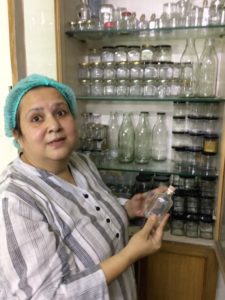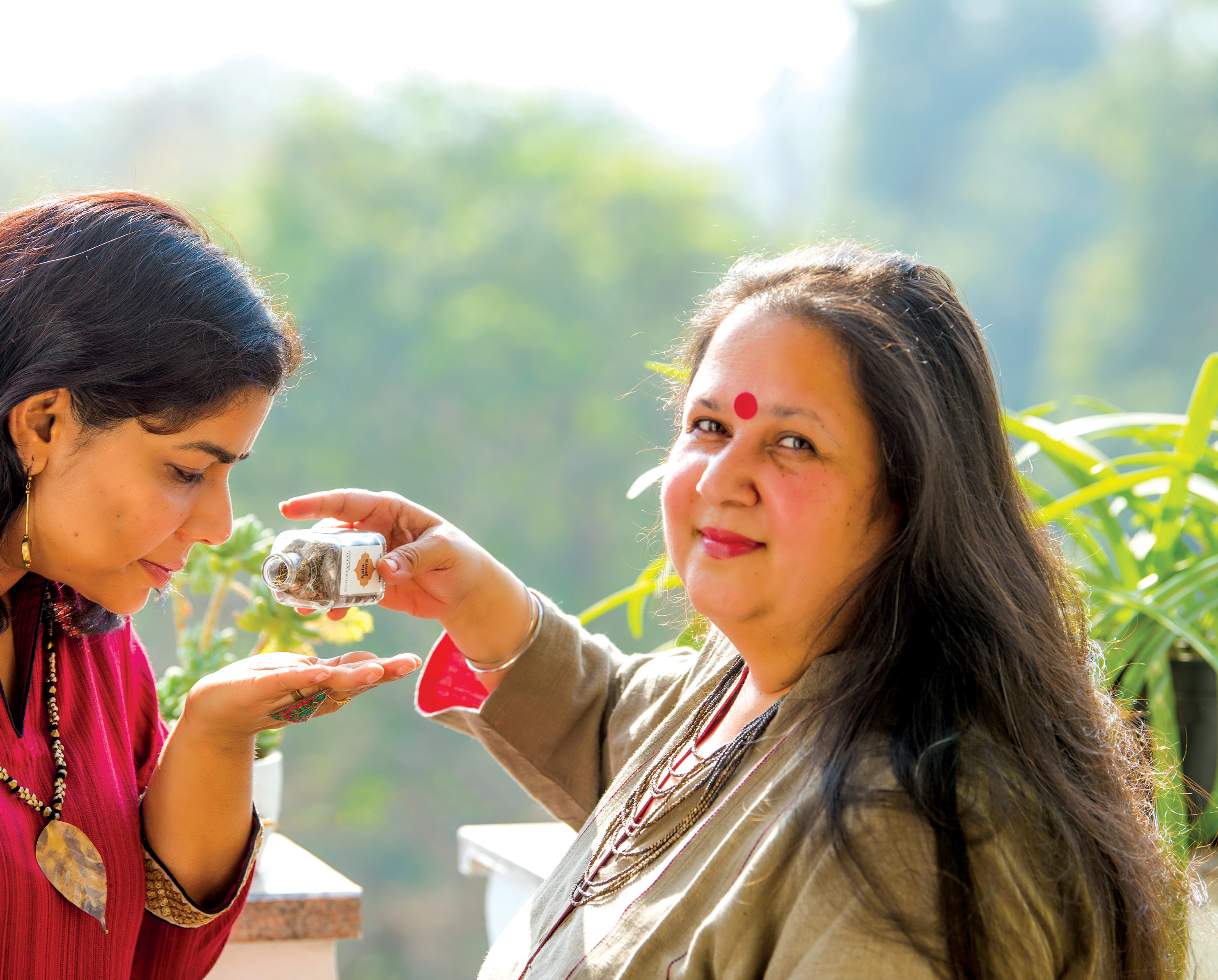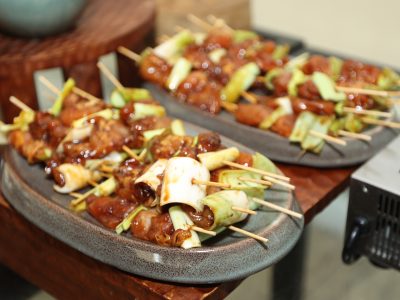Pallavi Chaturvedi endeavours to relive the childhood through culinary means. She’s a self-taught food anthropologist
Pallavi Chaturvedi’s presence brings solace. That’s not entirely because she cooks brilliantly and feeds liberally. The kitchen is the most active room of the house, sort of a food laboratory, where love is loaded into food. She loves food, eating and cooking. Recipes are experimented on a daily basis. Cooking for her is an art form and the flavours, herbs, spices and the texture are like layers of a painting. Pallavi doesn’t read books or surf the Internet for suggestions. Cooking is an innate process of self-expression. The apt adjective to describe her food, pickles and juices is homely.
Born to a Brahmin family from Lucknow, Pallavi, 46, was a rebel — she left the comfort of home early to fend for herself. She grew up in a house with a big courtyard where her grandmother, mother and aunts would make pickles, papad and deal with flavours of the land. A venue for slow food that involves a process of deriving the best from nature to tantalise the taste buds. And over generations, these lingering taste, flavours, fragrance and texture, which ingrained in her psyche, are quintessential to home and childhood memories.
But in this fast-paced world, all this is being lost to fast food, and the culture of eating out. Diversity of flavours is the victim of consumerist culture. While we may seem to be exposed to cuisines from across the globe, the local pallet of flavours is now a thing of nostalgia. Pickling as an activity that doesn’t happen in a nucleated family. Processed food is an onslaught of chemicals. And that was something Pallavi was not ready to expose her son Baahu who’s now 12-year-old.
Her husband Bandeep Singh, who is a journalist by profession, is also her partner inside the kitchen. While Pallavi is blessed with profound olfactory ability, Bandeep can decipher intricate ingredients by tasting the food; they tread a different sensory path to arrive at the same conclusion. Three years ago, they founded Courtyard Memories. Ginger and turmeric were two harbingers of the past, the childhood. In their words, “of cosy winter afternoons, lingering fragrances, sounds of chopping, grating, sifting in the backdrop of soft humming of the folklore; old china urns brimming with turmeric tainted mangoes, chillies, lemons, sun and shade, soft muslin cloths and yellowed fingertips.”
Courtyard Memories is an endeavour to relive the shared memories of tastes and smells, to connect to “our roots” via food.

They converted their old DDA flat in South Delhi into a pickle factory. Pallavi is now a repository of grandma’s recipes, or a way of life. Her source of information, and wisdom, are many grandmothers. Seated on a bench, with her head covered–“hair is the biggest enemy of pickles,” she says–with a tray full of delicious concoctions of ginger and turmeric in lime. She doesn’t use chemicals. September to February is the busy season when the two are harvested, both have great medicinal value and should be incorporated in our everyday meals for a healthy living.
As we sample her ginger and turmeric products, she talks about the processes — very organic and exploratory in nature — like a treasure hunt. One of their prime products is First Flush Tender Himalayan Ginger, which is an outcome of an unrelenting quest to find the finest ginger — they call it the single malt of ginger. Their quest ended in the inner reaches of Himachal Pradesh from where they now source the tender Himalayan Ginger directly from the farmers, like most of their other ingredients. They were seeking a balance between the stages of tenderness and the taste of ginger. “We sourced the ginger at a pre-harvest stage, when the main bulbs are not fully formed and the ginger is just beginning to acquire its sharp taste,” she explains.
The ginger shoots were graded and individually hand sliced for bite size, in square columns of the same size and lime juice added to it. “Lime is sourced from a single plantation,” she says pointing out to the distinction between lime and lemon, the latter is sourer. She prefers lime with thin skin, so that it doesn’t overwhelm the taste of ginger. Now, while slicing these tender ginger pieces of equal size in square columns slices, there was lot of wastage. They juiced up the ginger to make what they called the Himalayan Ginger Ale, which has sharp zesty flavour, a “coolant which perks the senses” is an exquisite cocktail mix. The by-product soon became the main product. Then the Amada Ginger Ale is made from ginger sourced from Gujarat, as the name suggest, has an aftertaste of fresh raw mango, is a big hit.
A vegetarian, Pallavi, makes the best non-vegetarian pickles in the town. Bandeep gets to sample hem, one of the perks of being married to Pallavi. The three preservatives used here are “Nimbu, namak, chini khansari (lemon, salt and organic sugar),” she emphasises, in more than 20 products she makes. And her chief advisors are her mother, mother-in-law, aunts, and elderly women bestowed with traditional knowledge.
“This is the last generation — the 75-80-year olds,” cautions Pallavi, who are the repository of slow food traditions. They have not been documented well, which she plans to do. She also took classes in schools to teach pickling to kids as a hobby, but got the wrath of mothers who hate entering kitchens.
And it’s not just about the outcome, but the process as well. Slow food is a community or a family activity, a sort of rallying point. And the therapeutic quality of converting raw food into sumptuous delight by aligning with the forces of nature—the sun in particular —cannot be overstated. It’s almost meditative.

Most of the ladies that work for Pallavi — a core team of five — are all mothers, living in urban slums, who have been dealing with their abusive, alcoholic husbands. They are in sync with varied activities like cleaning, chopping, drying, pickling, juicing and bottling. These activities, though repetitive, require single-minded focus — akin to chanting. They, in the process, gain composure and resolve to make their lives better.
Fairly native like the recipes, Govind Kumar Yadav joined as an office boy when he was 18 years old, pursued education, and now manages the accounts of Courtyard Memories on a computer. He is Pallavi’s man Friday. Marketing is a problem. She participates in various fares to introduce her products. INTACH has taken interest .
After ginger and turmeric, she turned her attention to shahtut or mulberry. Pallavi’s latest obsession, though, is Buddha’s hand, a citron— a fragrant citrus fruit with a thick rind — found in the North East.
I have a feeling, her journey has only begun and her friends are going to be the grateful beneficiaries.





